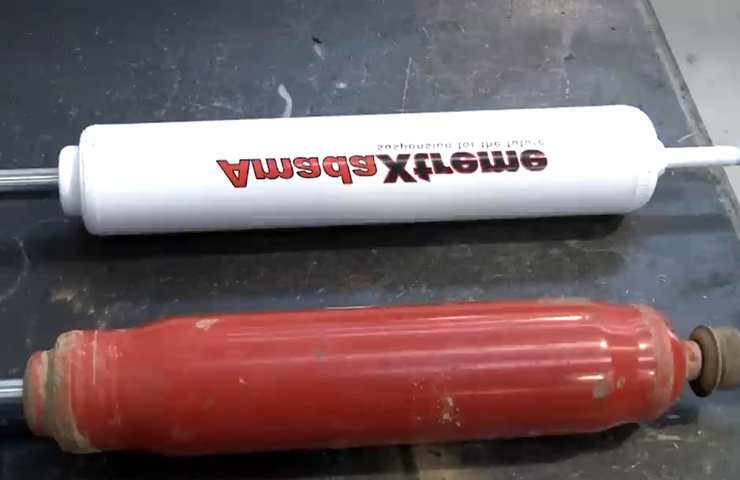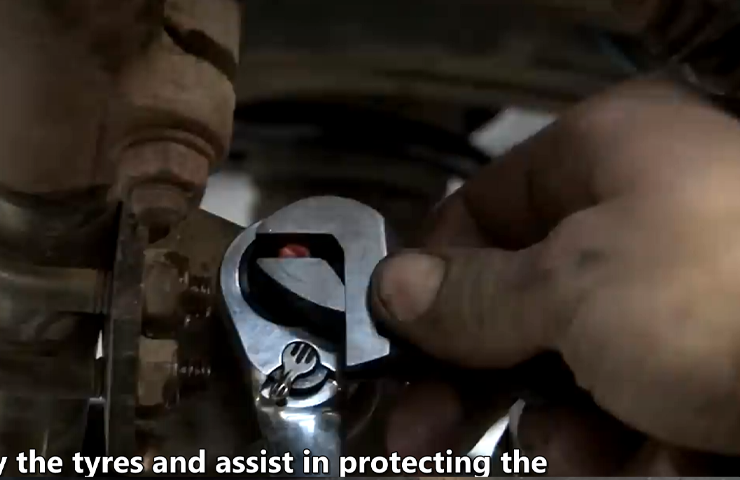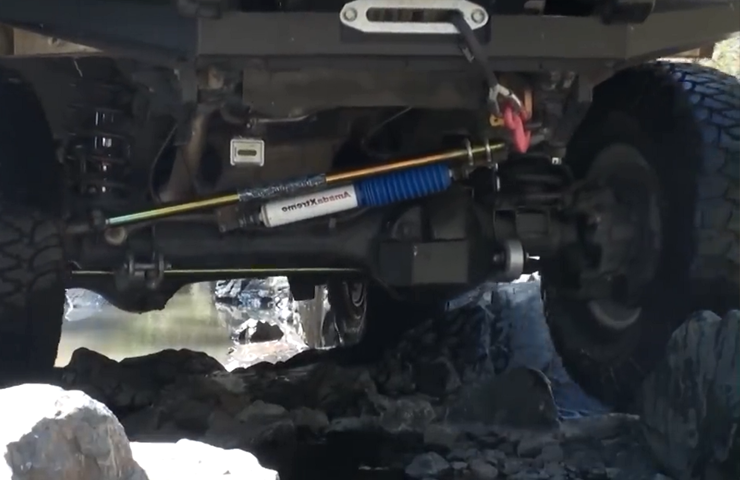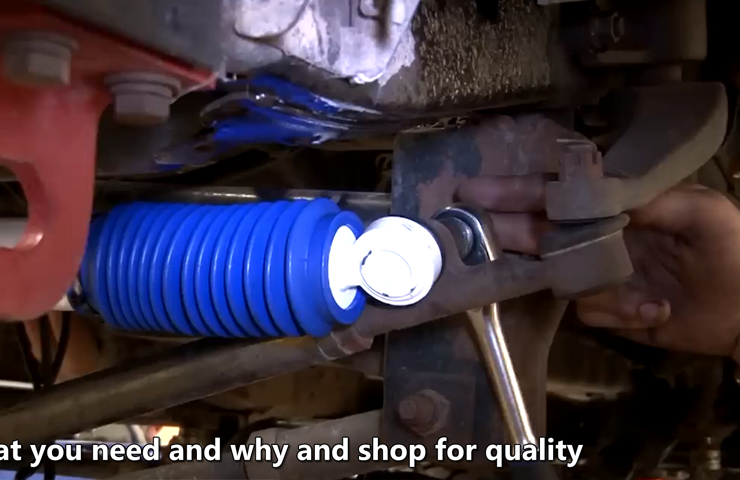To install an aftermarket steering stabilizer, follow these steps: First, locate the factory stabilizer and remove it. Next, attach the aftermarket stabilizer in its place.
What Is A Steering Stabilizer?
A steering stabilizer, also known as a steering dampener, is a device that helps reduce vibrations and control steering wheel movements in vehicles. It is typically installed between the vehicle’s steering components to provide additional stability and control while driving.
Definition and Explanation of a Steering Stabilizer
A steering stabilizer can be defined as a hydraulic or gas-charged shock absorber-like mechanism designed to minimize the effects of steering wheel vibrations and movements caused by irregularities on the road surface or aggressive maneuvers. It works by dampening the oscillations and shocks transmitted from the wheels to the steering components, making it easier for the driver to maintain control over the vehicle.
The Purpose and Benefits of Installing an Aftermarket Steering Stabilizer
Installing an aftermarket steering stabilizer provides several benefits for your vehicle’s handling and performance. Here are some of the notable advantages:
- Improved Steering Control: A steering stabilizer helps reduce the effects of wheel vibrations and impacts, allowing for smoother and more precise steering control. This is especially important off-road or during high-speed driving conditions when maintaining control is crucial.
- Reduced Steering Wheel Wobble: If you experience excessive steering wheel wobble, installing a steering stabilizer can significantly minimize the issue. The stabilizer absorbs the energy generated from irregular road surfaces and prevents it from being transmitted to the steering wheel, reducing wobbling and shaking.
- Enhanced Stability and Handling: By minimizing wheel vibrations, a steering stabilizer improves overall stability and handling of the vehicle. It provides a more comfortable driving experience and reduces the risk of losing control or experiencing sudden steering movements.
- Extended Steering Component Life: A steering stabilizer helps reduce wear and tear on steering components like tie rods, ball joints, and the steering gearbox. By absorbing the shocks and stresses, it helps prolong the lifespan of these critical parts, saving you money on repairs and replacements in the long run.
Common Signs that Indicate You May Need a Steering Stabilizer
If you notice any of the following signs while driving your vehicle, it may indicate that you need to install a steering stabilizer:
- Steering Wheel Vibration: Excessive steering wheel vibrations, especially at higher speeds or when going over bumps, can be a sign of a worn-out or inadequate steering stabilizer.
- Steering Wheel Wobble: If your steering wheel wobbles or shakes uncontrollably, especially during braking or when driving on rough roads, it could be due to a lack of proper stabilization.
- Difficulty Maintaining Control: If you find it challenging to maintain control of your vehicle, especially during off-road adventures or when towing heavy loads, a steering stabilizer can help enhance stability and make steering more manageable.
- Uneven Tire Wear: Steering instabilities caused by a faulty or insufficient steering stabilizer can lead to irregular tire wear patterns. If you notice uneven tire wear on your vehicle, it may be worth considering a steering stabilizer upgrade.
By recognizing these signs and understanding the importance of a steering stabilizer, you can take the necessary steps to ensure your vehicle’s steering system is optimized for safety, comfort, and performance.
Selecting The Right Steering Stabilizer
Factors to consider when choosing an aftermarket steering stabilizer
When it comes to selecting the right aftermarket steering stabilizer for your vehicle, there are several important factors to consider. By understanding these factors and taking them into account, you can ensure that you choose a stabilizer that meets your specific needs and enhances your overall driving experience.
1. Vehicle type and usage: The first factor to consider is the type of vehicle you have and how you plan to use it. Different stabilizers are designed for different vehicle types, such as trucks, SUVs, or off-road vehicles. Additionally, if you regularly engage in heavy towing or off-roading, you may need a heavy-duty stabilizer that can handle the extra stress.
2. Driving conditions: Consider the conditions in which you typically drive. If you frequently encounter rough roads, potholes, or uneven terrain, a stabilizer with adjustable damping may be beneficial. This will allow you to fine-tune the stabilizer’s performance to better compensate for unpredictable road conditions.
3. Budget: While it is essential to find a stabilizer that meets your needs, it is also vital to consider your budget. Stabilizers come in a range of prices, and it is important to find one that offers a good balance between quality and affordability. However, keep in mind that investing in a higher-quality stabilizer may ultimately save you money in the long run by providing better performance and durability.
Understanding the different types and designs of steering stabilizers
When researching steering stabilizers, it is helpful to understand the different types and designs available. This knowledge will enable you to make an informed decision and choose the stabilizer that best suits your specific needs.

1. Hydraulic stabilizers: Hydraulic stabilizers are the most common type and work by using fluid to dampen vibrations and shocks. These stabilizers typically offer adjustable damping, allowing you to fine-tune the performance to your liking. They are also relatively easy to install and maintain, making them a popular choice among vehicle owners.
2. Gas-charged stabilizers: Gas-charged stabilizers use nitrogen gas to improve their damping capabilities. These stabilizers are often recommended for heavy-duty vehicles or those that frequently experience extreme driving conditions. Gas-charged stabilizers provide superior control and stability, particularly in off-road or towing situations.
3. Steering damper kits: Some aftermarket steering stabilizers come in the form of complete steering damper kits. These kits often include additional components, such as brackets and mounting hardware, to ensure a proper and secure installation. They can be a convenient option for those looking to replace their entire stabilizer system.
How to properly match the stabilizer to your vehicle’s specific needs
Properly matching the stabilizer to your vehicle’s specific needs is crucial to ensure optimal performance and safety. Follow these steps to make sure you choose the right stabilizer:
- Research: Do thorough research on available stabilizers and familiarize yourself with the options. Read customer reviews and seek recommendations from trusted sources to gain insights into each stabilizer’s performance and durability.
- Consult with experts: If you have any doubts or questions while researching, consult with experts or professionals in the field. They can provide valuable guidance based on their experience and knowledge.
- Check compatibility: Before making a final decision, double-check the stabilizer’s compatibility with your vehicle’s make, model, and year. This information should be clearly indicated by the manufacturer.
- Consider customization: If you have unique needs or preferences, consider whether the stabilizer allows for customization or the use of additional components. This will ensure that you can tailor the stabilizer to your specific requirements.
- Installation and adjustment: Once you have selected a stabilizer, follow the manufacturer’s instructions for installation. When properly installed, make any necessary adjustments to achieve the desired performance according to your specific needs.
By considering the various factors, understanding the different types and designs, and properly matching the stabilizer to your vehicle’s specific needs, you can confidently select the right aftermarket steering stabilizer. This will not only enhance your driving experience but also contribute to improved safety and control on the road.
Step-By-Step Installation Guide
Installing an aftermarket steering stabilizer can greatly improve the handling and stability of your vehicle. Whether you are an off-road enthusiast or simply want to enhance your daily driving experience, this step-by-step installation guide will walk you through the process of installing a new steering stabilizer. From preparing your vehicle to adjusting the stabilizer for optimal performance, follow these instructions to ensure a successful installation.
Necessary tools and equipment for the installation process
Before you start the installation, make sure you have the following tools and equipment:
- Socket set
- Wrench set
- Jack and jack stands
- Torque wrench
- Penetrating oil
- Grease
Preparing your vehicle for the installation
Prior to installing the aftermarket steering stabilizer, take the time to prepare your vehicle:

- Ensure the vehicle is parked on a level surface and the engine is turned off.
- Using the jack and jack stands, elevate the front end of the vehicle to gain access to the steering system.
- Use the socket set and wrench set to loosen the bolts and nuts that secure the old stabilizer (if applicable).
- Apply penetrating oil to any stubborn bolts or nuts that are difficult to remove.
Installing the aftermarket steering stabilizer
Now it’s time to install the new steering stabilizer:
- Mount the new stabilizer in the designated location, following the manufacturer’s instructions.
- Ensure all bolts and nuts are tightened to the specified torque using the torque wrench.
- Apply grease to the pivot points of the stabilizer to ensure smooth movement.
Removing the old stabilizer (if applicable)
If you are replacing an existing steering stabilizer, follow these steps to remove it:
- Use the socket set and wrench set to loosen the bolts and nuts that secure the old stabilizer.
- Carefully remove the old stabilizer from the mounting location.
- Inspect the mounting area for any signs of wear or damage. Clean if necessary.
Mounting the new stabilizer
To mount the new stabilizer, follow these steps:
- Align the new stabilizer with the mounting location.
- Tighten the bolts and nuts securely using the socket set and wrench set.
Connecting the stabilizer to the steering system
Now it’s time to connect the stabilizer to the steering system:
- Identify the appropriate connection points on both the stabilizer and the steering system.
- Insert the connecting hardware provided with the stabilizer into the respective connection points.
- Tighten the hardware securely using the socket set and wrench set.
Adjusting the stabilizer for optimal performance
Lastly, adjust the stabilizer for optimal performance:
- Start the vehicle and turn the steering wheel lock to lock to test the stabilizer’s performance.
- Observe the vehicle’s handling and stability while making adjustments as needed.
- Repeat the adjustment process until the stabilizer provides a smooth and controlled steering experience.
Congratulations! You have successfully installed an aftermarket steering stabilizer. Enjoy the improved handling and stability of your vehicle.
Check And Test The New Steering Stabilizer
Once the aftermarket steering stabilizer has been installed on your vehicle, it is important to check and test its functionality to ensure optimal performance. This step-by-step guide will walk you through the process of inspecting the installation for any issues or loose connections, testing the steering stabilizer’s functionality and responsiveness, and troubleshooting potential problems and adjustments.
Inspecting the installation for any issues or loose connections
Before testing the new steering stabilizer, it is crucial to inspect the installation for any potential issues or loose connections. Carefully examine all the components and make sure they are securely fastened. Check the mounting brackets, bolts, and nuts to ensure they are tightened properly. Inspect the stabilizer itself for any signs of damage or leaks. If you notice any loose connections or problems during this inspection, address them before proceeding to the next step.
Testing the steering stabilizer’s functionality and responsiveness
Once you have confirmed that the installation is secure and there are no loose connections, it’s time to test the steering stabilizer’s functionality and responsiveness. Start the engine and turn the steering wheel from lock to lock, paying attention to any vibrations or wobbles. The steering stabilizer should help reduce any excessive steering play, improve steering control, and minimize any shimmy or vibration. Take note of how the steering stabilizer performs during different driving scenarios, such as on smooth roads, bumpy terrain, or when making sharp turns.

Troubleshooting potential problems and adjustments
If you encounter any issues or notice that the steering stabilizer is not performing as expected during the testing phase, it is important to troubleshoot and make any necessary adjustments. Check for any signs of leakage, which may indicate a damaged or faulty stabilizer. Inspect all connections once again and ensure they are tight. If there are still problems, refer to the manufacturer’s instructions or consult a professional for further assistance. Troubleshooting and addressing any issues promptly will help optimize the performance and longevity of your aftermarket steering stabilizer.
By following these steps to check and test the new steering stabilizer, you can ensure that it is installed correctly and functioning properly. Regularly inspecting and maintaining your steering stabilizer will not only enhance your driving experience but also contribute to better vehicle control and safety.
Maintenance And Safety Tips
Proper maintenance of an aftermarket steering stabilizer is essential to ensure its longevity and optimal performance. By following some simple practices, you can prolong the lifespan of your steering stabilizer and keep it functioning smoothly. Additionally, it is crucial to prioritize safety when working on the steering system or installing the stabilizer. This section outlines regular maintenance practices, tips for keeping the stabilizer clean, and safety precautions to follow:
Regular maintenance practices to ensure the steering stabilizer’s longevity
- Inspect the steering stabilizer regularly for any signs of damage, such as leaks, cracks, or loose connections.
- Tighten all the bolts and nuts that hold the stabilizer in place to prevent any unnecessary vibrations or rattling.
- Check the fluid levels in the stabilizer regularly and top up if necessary. Low fluid levels can affect its performance.
- Look for any signs of excessive wear or tear on the mounting brackets or bushings. Replace them if they appear worn out.
- Consider greasing the moving parts of the steering stabilizer periodically to ensure smooth operation.
Tips for keeping the stabilizer clean and free from debris
To maintain its functionality, it is crucial to keep your steering stabilizer clean and free from debris. Here are a few tips to ensure its cleanliness:

- Regularly wash the steering stabilizer with mild soap and water to remove dirt, mud, and road grime that can accumulate over time.
- Inspect the stabilizer for any debris buildup, such as rocks or twigs, and remove them carefully.
- If you frequently drive in dusty or muddy conditions, consider installing a protective cover or shield to prevent debris from getting trapped in the stabilizer.
Safety precautions when working on the steering system or stabilizer
Working on the steering system or installing an aftermarket steering stabilizer requires caution and adherence to safety guidelines. Here are some essential safety precautions to remember:
- Before starting any work, ensure that you have the necessary tools and equipment, and wear appropriate safety gear such as gloves and safety glasses.
- Always disconnect the battery before working on the steering system to prevent accidental deployment of the airbag or any electrical mishaps.
- Be cautious when handling heavy components and use proper lifting techniques to avoid strain or injury.
- Follow the manufacturer’s instructions carefully during the installation process and double-check all connections and fittings.
- If you are unsure or inexperienced in working on the steering system, it is advisable to seek professional assistance to avoid any potential safety hazards.
By following these maintenance practices and safety precautions, you can ensure the longevity and safe operation of your aftermarket steering stabilizer. Regular inspections, cleaning, and adherence to safety guidelines will help you enjoy a smoother and safer driving experience.
Frequently Asked Questions On How To Install Aftermarket Steering Stabilizer
Which Way Do You Mount A Steering Stabilizer?
Mounting a steering stabilizer involves attaching it to the vehicle’s frame and the steering linkage. Ensure the stabilizer is secured properly and aligned in the correct direction for optimal performance.
What Does A Steering Stabilizer Attach To?
A steering stabilizer attaches to the steering system of a vehicle.
Is A Steering Stabilizer Just A Shock?
No, a steering stabilizer is not just a shock. While both are designed to reduce vibrations and improve steering control, a stabilizer specifically focuses on minimizing steering wheel oscillations caused by rough terrain or large tires. It works in conjunction with the suspension system to enhance stability and safety while driving off-road.
Will A Steering Stabilizer Tighten Steering?
Yes, a steering stabilizer can tighten steering. It helps reduce vibration and movement, making the steering feel more controlled and stable. By minimizing unwanted movement, a steering stabilizer can enhance steering responsiveness and improve overall handling.
Conclusion
Installing an aftermarket steering stabilizer is a simple and effective way to improve your vehicle’s performance and safety. By reducing vibrations and steering wander, this upgrade enhances your driving experience. Follow the step-by-step instructions provided in this guide to properly install a steering stabilizer on your vehicle.
Don’t compromise your safety and control—take action now! Trust the process, and enjoy the benefits of a smooth and controlled steering system. Happy driving!
